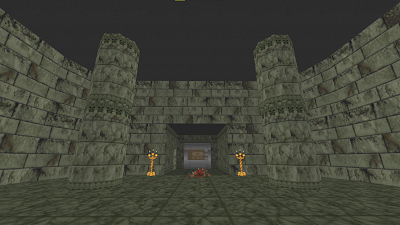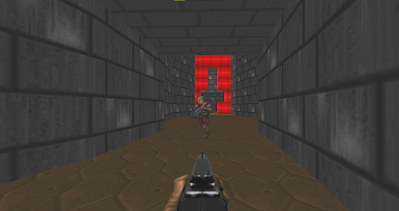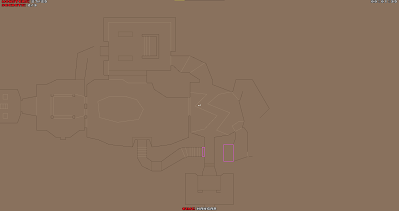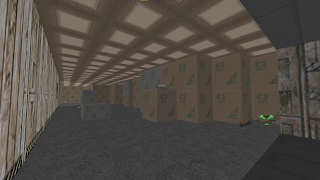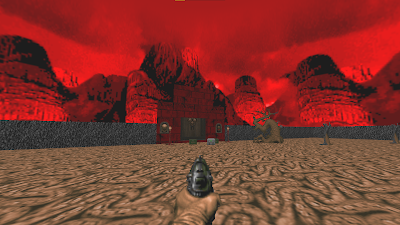With a blog name like "Boomer Shooter Book Club," it would feel a bit heretical (pun intended, I'm afraid, though it'll be a while before that write-up) to open with any other boomer shooter outside of id Software's flagship. More than any other game I could write about on this blog, 1993's DOOM is, by a long shot, the one with which most folks are likely to be familiar. Additionally, I already wrote about its significance and its place in the world of boomer shooters a little bit more in-depth on my history page. With those points in mind, I'll focus less on DOOM as an icon, nor will I attempt to properly "review" it, since what needs to be said about DOOM has already been said hundreds of times over, and in much more interesting ways than I could ever hope to achieve. Instead of focusing on what DOOM is in a vacuum, I'll instead offer you a few perspectives on this title, should you be a prospective first-time buyer or player of the game, or the genre as a whole.
Blast(s) from the past
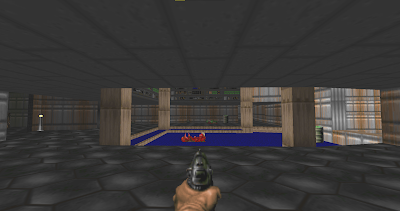 |
| From humble beginnings... |
If you haven't played DOOM, but you're interested in doing so, the most likely scenario is that you have plenty of experience with FPSes and are looking to try out one of the granddaddies of the genre. If so, allow me to offer a few pieces of advice before proceeding.
The Purchase
- (Not recommended) If you want the quickest and most hands-off way to experience this title without having to make any effort on your end, your best bet is to simply buy it off of one of the several online storefronts that sell it, including Steam or GOG, and immediately spin it up via that platform (i.e. click "Play" in your games library). DOOM is usually only $5 USD through those sites, is frequently on sale (it's actually 60% off on GOG's site at the time of this writing), and is absolutely worth the cost of admission. That said, spinning it up through these launchers is not the best way to experience the game, in my opinion. You'll be subjected to ~30 seconds of developer splash screens upon opening the game as well as some unnecessary Bethesda.net sign-on mess which will take another 30 seconds of time before you can even start the gameplay. This is a far cry from the reality of spinning up "vanilla DOOM" on your PC, as 60 seconds after opening the application, most folks are halfway through a level. If you're willing to do some legwork, you can experience DOOM with way less bloat and with far more creature comforts, should you desire to use them.
- (Recommended) With just a teensy bit of tinkering, once you obtain your own copy of DOOM from one of the above sites (or wherever else you'd prefer), you can avoid much of the bloat (including all the extra intro developer cutscenes and Bethesda.net sign-on) by moving the game into a separate file and running it through a slimmed-down version of DOSBox, Chocolate DOOM, or an enhanced source port such as GZDOOM. If boomer shooters are brand new to you in general, I would push you towards GZDOOM. Purists will hate this approach, but I think it's a lot more pleasant of a way for a boomer shooter newbie to enjoy these games. Playing DOOM without an enhanced port like GZDOOM can feel a bit daunting. There is no vertical look (meaning your mouse only lets you look left and right, never up or down) and no crosshair. Additionally, GZDOOM usually strikes a decent balance between enhanced lighting and visuals without totally demolishing the original visual appeal of these games. Playing them "as-is" out of the box, you'll see how crunchy some of the old sprites look at this point. There is some charm to it, and you'll surely grow to appreciate it, but again, if it's your first time trying a boomer shooter out, you might like to be eased into it using something like GZDOOM.
The gameplay
Not the first tutorial, or the introductory tutorial. I mean that's all you get from beginning to end, because it's all you need. And things are even a little more straightforward now if you're familiar with FPSes on PC already, because some of these controls have been further smoothed out. Sure, you can still move using the arrow keys (or move forward with the RMB, which would be quite the fun change of pace), but these games support WASD strafe + mouse movement out of the box now, so you'll feel right at home relatively quickly.
- Broadly speaking, the shotgun is the best weapon in the game, in that it's your "workhorse." It's nothing like the unrealistic portrayal of shotguns in modern games (unless the phrase Akimbo 1887s means anything to you). Decent range, will take out most trash mobs in a shot or two at most, relatively fast-firing, and most importantly, no reloading, ever. Just a pump between each shot.
- These older games all came with secrets hidden in each level. The "open/activate" key ("E" for most players, spacebar in the original game), when used on a hidden door or switch, will reveal a secret area, either directly in front of the player or hidden elsewhere in the level (sometimes on a timer). Some of these maps only include one or two secrets (or none at all). Some have over 10, including secret exits which lead to secret levels, which themselves have more secrets in them. The amount of secrets (and monsters) in a level are visible in a counter on the map screen.
- Speaking of the map screen, there is a map, and you ought to use it! The map, or automap as it is referred to in these games, can be viewed by pressing "tab," and will help immensely in keeping track of your movement throughout these levels, especially when having to backtrack after finding a key for a previously-locked door which you walked past a few minutes prior. Toggling the "follow mode" on or off, as well as setting markers, are both relatively under-utilized features that can actually make a big difference if you get comfortable with them.
- While the shotgun is your bread and butter in this game, all the weapons adhere to the "dance" that you may have encountered if you are familiar with 2016's DOOM or 2020's DOOM Eternal. Every weapon remains viable throughout the whole game (save the pistol, which is just a weaker version of the chaingun) and each serves its purpose in a room. Your moment-to-moment gameplay in DOOM will focus on entering a room, very quickly determining threat priority, and dealing with them appropriately. Hitscanners, i.e. enemies that do unavoidable immediate damage to you upon firing their weapons, should be dealt with first and foremost, since they cannot be "dodged" like enemies who shoot physical projectiles. After that, your plan of attack will vary depending on the room. Do you have a bunch of weaker enemies grouped up on a ledge / in a small area? Might be time for a rocket. A bunch of enemies spread out that you need to keep suppressed? The chaingun interrupts enemy attacks. Do you need everything to die, like, right now? Time to bust out the BFG 9000. Some ammo is more scarce than others, but learning to use your entire arsenal is important, since very few weapons will ever have enough ammo to be used exclusively for the entire game.
- Speaking of ammo conservation, the chainsaw is a melee weapon you'll hopefully find relatively early on in the game. It is a great way to take out single low-tier enemies at higher difficulties, since it has unlimited ammo (unlike the fuel reserves it has in the later entries) and its ability to stagger single enemies means you can often take out monsters without getting hurt yourself.
- If you have the time (and you like to nerd out over this stuff like I do), I highly recommend you check out the original manual for the game (link opens a .pdf file). While you really only need the tutorial screen I showed earlier, the manual does go into a bit more detail about the HUD, secrets, different item / weapon / armor pickups, enemies, and more. Plus, everybody knows that there's nothing better than ripping open a new game and reading the manual on your way back from the store.
- For those of you choosing to play DOOM using an enhanced port like GZDOOM, I have a few additional notes:
- First, and most importantly, GZDOOM's default configuration adds the ability to jump. This is not an intended gameplay mechanic, and while I do believe that you should enjoy the game how you want to enjoy it, I would highly recommend that you either disable jumping, or promise yourself that you'll avoid doing it. These games were designed without jumping in mind, and can be completed 100% without it. Utilizing jump will enable you to sequence-break many maps, which, while it sounds cool, will build poor habits of not figuring out the levels as they were intended to be played. There are lots of small gaps that you can cross over by running fast enough, which is basically DOOM's jump equivalent. That is by design. Jumping over tiny barriers that were put in place as a kind of lock is not by design, it's sequence-breaking. This is one of the few gameplay elements about which I will put my foot down (pun intended, and I won't apologize).
- Second, you can add a crosshair to the screen by searching in the settings for "HUD" and selecting the relevant items. I don't use a crosshair in these games unless a WAD author suggests it (which is rare to never, in my experience), but I mention it here in case the lack of a crosshair is a major turn-off for folks coming from a modern FPS standpoint. For what it's worth, I don't miss it at all when I play games in this engine.
- My previous point regarding crosshairs extends to a lot of the graphical enhancements as well. You can really crank up the fidelity of things like lighting, extra sprite animations, smoothing / interpolation, and all that mess, but I find that at a certain point, it begins to detract from the experience and actually becomes more distracting than it does helpful. Part of DOOM's charm is in its simplicity. Mods like Brutal DOOM, though I enjoy them for what they are, can very much feel like sensory overload, and there's a reason why I push for more stock "vanilla" gameplay for a newcomer (save the creature comforts found within GZDOOM which I've already mentioned).
- Finally, I wanted to discuss vertical look. I'll be the first to admit that I think the ability to look up and down is a major plus, though I need to clarify that it is not necessary at all to beat any of these games, since it wasn't designed originally with that feature in mind. Your bullets automatically travel up or down to enemies higher or lower than you when in range, whether you intend for them to do so or not. And yet, it just feels better to be able to look up and down while doing this, as superfluous as it is. Something rubs me the wrong way about a mouse not responding to a vertical input, y'know?
- Regarding skill levels, "Hurt me plenty." is considered the default difficulty. The easier difficulties reduce the amount of monsters that spawn, with the very easiest, "I'm too young to die.," also doubling the amount of ammunition that can be found and halving player damage. The harder difficulties increase the amount of monsters that spawn, with the very hardest, "Nightmare!," increasing enemy and projectile speed, as well as disabling cheats, and respawning monsters periodically throughout the mission. You should, of course, choose whichever skill level you prefer. As a person with a decent amount of FPS experience before picking up boomer shooters, "Hurt me plenty." was a fine jumping-in point, and "Ultra-Violence." is usually fine if I'm looking for a challenge, though I rarely choose it since I'm far more interested in experiencing the breadth of the genre over pushing myself to "master" each game.
- Finally, and somewhat related to skill level, these games do not have any checkpoints, and if you die, you will be returned to the beginning of the level. However, these games all have built-in quick-save and quick-load functionality. This means that, with the touch of a single button, you can save a snapshot of your game exactly as-is in the moment of the save, and upon quick-loading, will be returned to that exact moment. I highly recommend you take advantage of this functionality early and often, as it will save you a lot of time in the long run. "Purists" will play through these games without utilizing quick-save or quick-load and instead only manually save as a "bookmark" between levels. "Purists" consider quick-saving and quick-loading in order to stop yourself from losing too much progress to be "save-scumming" and is generally frowned upon. I would now like to direct purists to the bottom of page four of the original DOOM game manual:
"TIP: Save your game and save it often. When you die, you're back to the beginning of the level, toting that little pistol again. That ain't good, especially after you progress to some of the tougher levels."
I would next like to direct purists to my shorts, which they can eat.

